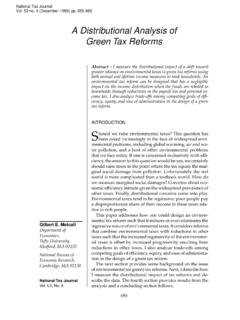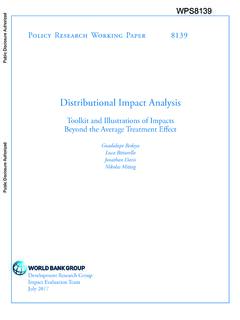Transcription of Benefits and Costs from Sulfur Dioxide Trading: A ...
1 Benefits and Costs from Sulfur Dioxide trading : A distributional analysis Ronald J. Shadbegian, Wayne B. Gray, and Cynthia L. Morgan Working Paper Series Working Paper # 05-09 December, 2005 Environmental Protection Agency National Center for Environmental Economics 1200 Pennsylvania Avenue, NW (MC 1809) Washington, DC 20460 Benefits and Costs from Sulfur Dioxide trading : A distributional analysis Ronald J. Shadbegian, Wayne B. Gray, and Cynthia L. Morgan Correspondence: Ron Shadbegian 1200 Pennsylvania Ave Mail Code 1809T Washington, DC 20460 202-566-2374 NCEE Working Paper Series Working Paper # 05-09 December, 2005 DISCLAIMER The views expressed in this paper are those of the author(s) and do not necessarily represent those of the Environmental Protection Agency. In addition, although the research described in this paper may have been funded entirely or in part by the Environmental Protection Agency, it has not been subjected to the Agency's required peer and policy review.
2 No official Agency endorsement should be inferred. Benefits and Costs from Sulfur Dioxide trading : A distributional analysis Ronald J. Shadbegian* University of Massachusetts, Dartmouth EPA, National Center for Environmental Economics Email: Wayne Gray Clark University and NBER Email: Cynthia Morgan EPA, National Center for Environmental Economics Email: * The authors wish to thank Douglas Latimer, currently with EPA Region 8, for providing us with the Source-Receptor Matrix Model and for insightful conversations about how to use the model. We are grateful to seminar participants at Harvard and the 2004 AERE Summer Workshop for helpful comments and to Denny Ellerman and Nathaniel Keohane for providing us with cost data. The opinions and conclusions expressed are those of the authors and not the United States Environmental Protection Agency. Abstract Policy-makers and others interested in environmental justice (EJ) are concerned that poor and minority communities are disproportionately exposed to pollution.
3 Title IV of the 1990 Clean Air Act Amendments required the dirtiest coal-fired utilities to cap their SO2 emissions at million tons per year starting in 1995. At the same time, there was a major regulatory regime change with respect to the regulation of coal-fired utilities, shifting from command-and-control emission standards to a system of tradable allowances. In this paper, we examine the distribution of Costs and health Benefits across different regions and socioeconomic groups associated with the air quality improvements mandated under Title IV. We examine data on the 148 coal-fired utilities which were regulated under Title IV and find as expected that the monetary Benefits of reduced SO2 emissions under Title IV greatly outweigh the Costs : we estimate Benefits of nearly $56 billion and Costs of just $558 million. Not unexpectedly the net Benefits are positive in every EPA region, but are highly concentrated. We find that nearly 90% of the Benefits and Costs of the overall reductions under Title IV are concentrated in 4 regions the northeast, north central, mid-Atlantic, and southeast.
4 Furthermore, when we examine the socio-economic distribution of net Benefits , we find that the poor received slightly lower Benefits on average from Title IV, which could raise some EJ concerns, if the poor purchase as much electricity as the rich. On the other hand, the African-American and Hispanic communities received a disproportionately larger share of the Benefits relative to their Costs . Hence our study indicates that there are no significant EJ concerns raised by Title IV. Key Words: air quality, Clean Air Act Amendments, environmental justice, Benefits , Costs , trading Subject Matter Classifications: Air Pollution, Benefit- cost analysis , distributional Effects, Pollution Control Options and Economic Incentives I. Introduction Prior to the passage of Title IV of the 1990 Clean Air Act Amendments (CAAA), there had been a lively debate involving Congress, the Environmental Protection Agency (EPA), and academics, about the need for reducing Sulfur Dioxide (SO2) emissions due to the problem of acid rain.
5 In addition to domestic pressure, Canada was putting political pressure on the to decrease acid rain. Just after the passage of the CAAA the and Canada signed the Canada-United States Air Quality Agreement, aimed at controlling transboundary acid rain. How damaging is acid rain? The National Acid Rain Precipitation Assessment Program found that acid rain causes minor damage to crops and modest damage to aquatic life in acidified lakes and streams. Burtraw et al (1997) estimate the expected environmental Benefits from recreational activities, residential visibility, and morbidity to be about $13 per capita in 1990. On the other hand, SO2 also combines in the atmosphere with ammonia to form sulfates fine particulates ( ) which have been shown in several studies to contribute significantly to pre-mature mortality. Thus, even if acid rain has only a marginal environmental impact, reductions in SO2 emissions have additional (and potentially much larger) health Benefits , through reduced pre-mature mortality.
6 EPA (2003) estimates that the human health Benefits of the Acid Rain Program will be roughly $50 billion annually, due to decreased mortality, fewer hospital admissions and fewer emergency room visits, by the year 2010. Coal from fossil-fuel fired electric utilities accounts for most of SO2 emissions in the United States. Title IV of the 1990 CAAA set an annual 9 million ton cap on SO2 emissions from all fossil fuel fired electric utilities. This cap, which is to be fully achieved by 2010, requires the affected electric utilities to reduce their aggregate SO2 emissions by 10 million tons below their 1980 levels. Along with requiring substantial SO2 reductions Title IV also abandoned the 2 command-and-control approach to the regulation of utilities, where utilities were required to meet individual emission standards set by regulators, in favor of a more flexible, cost -efficient tradable permit approach.
7 This more flexible approach made the substantial SO2 reduction politically feasible and is widely believed to have led to tremendous cost savings relative to the command-and-control approach. Keohane (2003) estimated that the system of allowance trading resulted in cost savings between $150 million and $270 million annually, compared to a uniform emissions-rate standard. Title IV allows permits to be bought and sold freely anywhere in the continental United Allowing permits to be bought and sold freely may inadvertently create a divergence between the people who are paying for the SO2 reductions and those that are benefiting from the reductions. Morgan and Shadbegian (2003) find that the SO2 trading program may have inadvertently resulted in some environmental injustices mainly higher levels of emissions in disproportionately poor and minority In this paper we extend the work of Morgan and Shadbegian by examining the spatial distribution of the Costs and Benefits associated with air quality improvements that occurred during the first year under Title IV of the CAAA.
8 The air quality improvements are measured relative to the level of emissions under the former command-and-control regime, which allowed a greater level of emissions. We examine the spatial distribution of the Costs and Benefits both in 1 The only time a plant would be prevented from buying allowances to emit more SO2 would be if that plant was located in a county which was in violation of the National Ambient Air Quality Standard (NAAQS) for SO2, which were set at levels to prevent local adverse health outcomes. However, this has rarely posed a problem for permit trading since the Title IV cap requires a significantly greater reduction of aggregate SO2 emissions than what is required to meet the NAAQS for SO2. 2 According to the Office of Environmental Justice at EPA, environmental justice exists when no group of people, including racial, ethnic, or socioeconomic group, .. bear[s] a disproportionate share of the negative environmental consequences resulting from industrial, municipal, and commercial operations.
9 3 terms of the states and regions being affected and the socio-economic composition of the affected population. The vast majority of dollar-valued Benefits from air pollution abatement arise from the impact of airborne particulates ( ) on premature mortality. A 1995 EPA study reports that of the estimated $ trillion worth of Benefits derived from the Clean Air Act of 1970, reductions in particulate-related mortality contributed more than $20 trillion. We use a spatially-detailed air pollution dispersion model (the Source-Receptor Matrix) to evaluate the impact of SO2 emission reductions from each plant on county-level concentrations of particulates during Phase I of Title IV. Using existing evidence on the connection between particulate exposures and mortality, we translate the reductions in secondary particulate concentrations in each county in the into the dollar Benefits from reductions in pre-mature mortality. Who pays for the improvements in air quality?
10 One possible answer is nobody , if efficiency improvements resulting from the new emissions trading system ( more flexible production switching, less uncertainty about regulatory requirements) outweigh the additional abatement Costs on a plant-by-plant basis. A more likely scenario is that some plants face higher Costs of abatement, which are passed along to their customers. If some plants increase their emissions and buy additional allowances, the population affected by the worsening air quality will be paying some of the Costs of the greater air quality improvements near other plants that reduced their emissions in order to sell the allowances. Arrow et al (1996) argue that along with a cost -benefit analysis measuring the aggregate net Benefits from a regulation, a good analysis will also examine the distributional consequences. In this paper we compare the overall net health Benefits that were achieved under Title IV along with the spatial distribution of those net Benefits to test whether there were unforeseen 4 consequences of the regulatory change in terms of adverse impacts on particular regions or socio-economic groups.



















